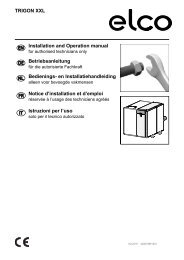Nimbus Compact M NET R32 Installation Manual UK
Create successful ePaper yourself
Turn your PDF publications into a flip-book with our unique Google optimized e-Paper software.
Hydraulic connections<br />
4.2 <strong>Installation</strong> of the Hydraulic KIT<br />
4.2.1 Safety inlet assembly<br />
It must be installed on the domestic hot water inlet before the<br />
water enters the tank. It consists of a pressure reducing valve,<br />
an expansion relief valve and a check valve, and connects the<br />
system to the expansion vessel.<br />
4.2.4 Safety device connection<br />
T&P relief valve<br />
The factory-fitted temperature and pressure relief valve on top<br />
of the cylinder is a safety device that backs up the thermostatic<br />
control device(s) and non self-resetting energy cut-out(s). It<br />
works by sensing an excess water temperature or pressure and<br />
discharging the hot water.<br />
General structure<br />
1<br />
2<br />
Possible T&P valve connection<br />
Discharge pipes from the temperature & pressure relief valve<br />
(T&P) and expansion relief valve may be joined together. For<br />
connection to the discharge line of the T&P pressure and relief<br />
valve, use the water connection (male, G ½”) located on the<br />
side of the indoor unit.<br />
7<br />
6<br />
5<br />
4<br />
3<br />
Fig. 47<br />
Safety device assembly information<br />
Safety devices should discharge either directly or by way of a<br />
manifold via a short section of metal pipe (D1) to a tundish. The<br />
diameter of discharge pipe (D1) should be not less than the<br />
nominal outlet size of the safety device, e.g. temperature relief<br />
valve. Where a manifold is used, it should be sized to accept<br />
and discharge the total flow from the discharge pipes connected<br />
to it.<br />
The tundish should be arranged vertically in the same space as<br />
the non-vented hot water storage system, and should be fitted<br />
as close as possible to the safety device, in a lower position,<br />
with no more than 600 mm of pipe between the valve outlet<br />
(T&P) and the tundish. Do not install the tundish near electrical<br />
devices (see Fig. 47).<br />
1 Expansion relief valve (set to 6 bar)<br />
2 Service 3/4” pressure reducing cartridge and line strainer<br />
(set to 3.5 bar)<br />
3 Cold mains water inlet (22 mm)<br />
4 Balanced cold water take-off with non-return valve (22<br />
mm)<br />
5 3/4” BSP connection for expansion vessel<br />
6 To cylinder (22 mm)<br />
7 Expansion relief outlet to tundish (15 mm)<br />
If the Cold Water Balanced Takeoff is not used, a cap shall be<br />
installed.<br />
4.2.2 Exspansion vessel<br />
The expansion vessel must be connected to the dedicated inlet<br />
on the safety inlet assembly.<br />
Check with your local water authority on what type of installation<br />
is acceptable in order to conform to the applicable building<br />
regulations and standards.<br />
4.2.3 Tundish<br />
Installed in the discharge pipe after the valves, it provides an air<br />
break allowing the discharged flow to be safely conducted to<br />
the termination point. The tundish also provides a visible indication<br />
of the discharge and functions as backflow prevention<br />
device. To install it correctly, refer to paragraph Safety device<br />
connection.<br />
Discharges<br />
Any discharge should be visible at the tundish. In addition,<br />
where discharges from safety devices may not be evident, e.g.<br />
houses inhabited by people with impaired vision or mobility,<br />
it may be useful to install a suitable safety device to warn people<br />
when the discharge occurs, e.g. an electronically operated<br />
device.<br />
Connection of the discharge pipe (D2) to the tundish<br />
The discharge pipe (D2) arriving from the tundish should:<br />
– have a vertical pipe section at least 300 mm long below<br />
the tundish before any elbows or bends in the pipework<br />
(see Fig. 47);<br />
– be installed with a continuous fall of at least 1 in 200<br />
thereafter.<br />
Examples of discharge arrangements<br />
The discharge pipe (D2) from the tundish should terminate in<br />
a safe place where there is no risk for people in the vicinity of<br />
the discharge.<br />
Below are some examples of acceptable discharge arrangements:<br />
– to a trapped gully with the end of the pipe below a<br />
fixed grating and above the water seal;<br />
– downward discharges at low level, i.e. up to 100 mm<br />
above external surfaces such as car parks, hard standings,<br />
grassed areas, etc. are acceptable, provided that a<br />
wire cage or similar guard is positioned to prevent contact,<br />
whilst maintaining visibility;<br />
EN / 29

















